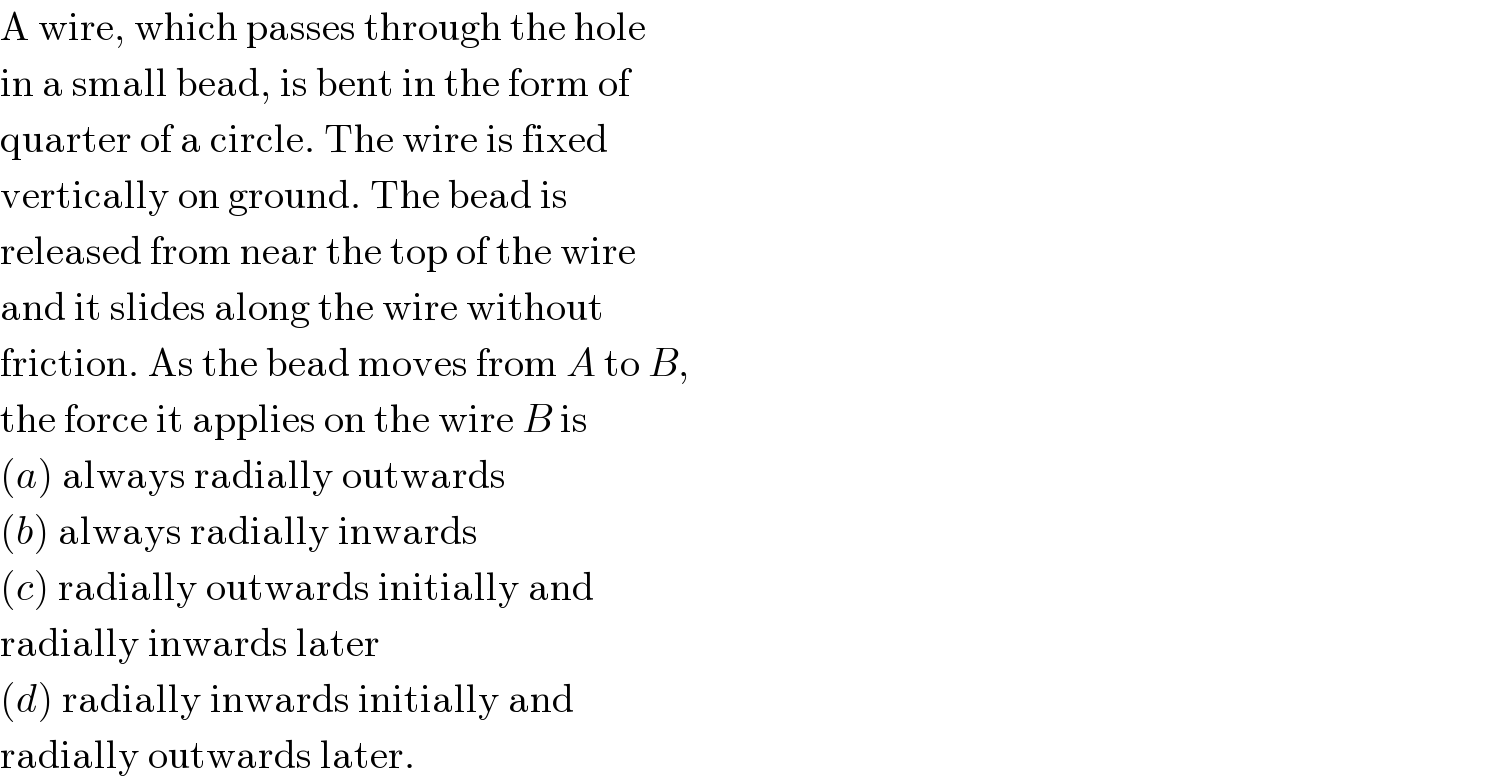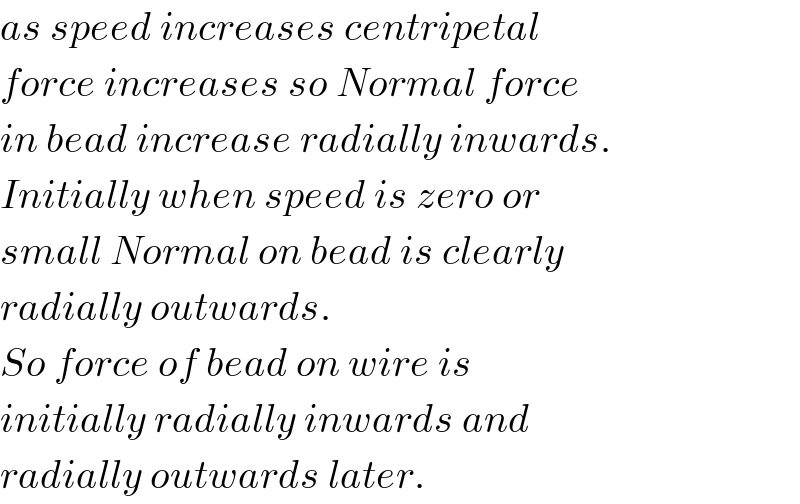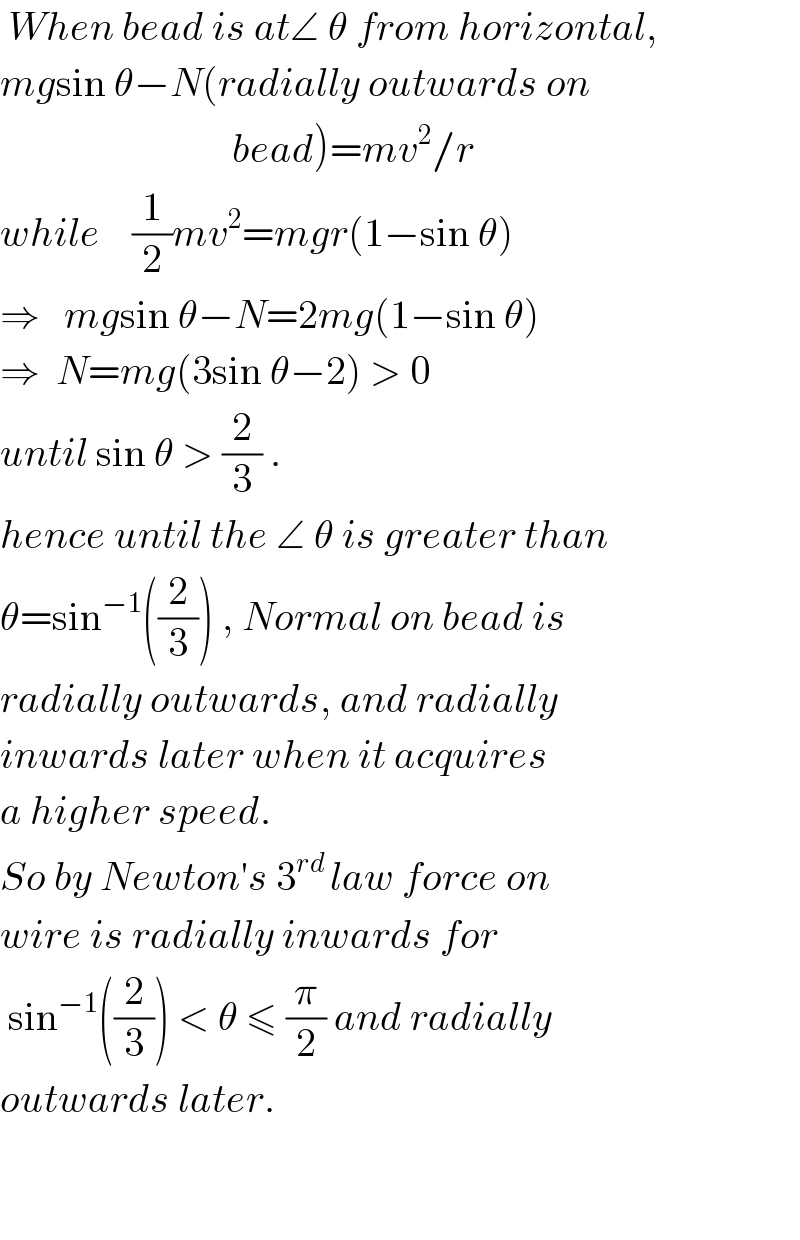
Question Number 22286 by Tinkutara last updated on 14/Oct/17

$$\mathrm{A}\:\mathrm{wire},\:\mathrm{which}\:\mathrm{passes}\:\mathrm{through}\:\mathrm{the}\:\mathrm{hole} \\ $$$$\mathrm{in}\:\mathrm{a}\:\mathrm{small}\:\mathrm{bead},\:\mathrm{is}\:\mathrm{bent}\:\mathrm{in}\:\mathrm{the}\:\mathrm{form}\:\mathrm{of} \\ $$$$\mathrm{quarter}\:\mathrm{of}\:\mathrm{a}\:\mathrm{circle}.\:\mathrm{The}\:\mathrm{wire}\:\mathrm{is}\:\mathrm{fixed} \\ $$$$\mathrm{vertically}\:\mathrm{on}\:\mathrm{ground}.\:\mathrm{The}\:\mathrm{bead}\:\mathrm{is} \\ $$$$\mathrm{released}\:\mathrm{from}\:\mathrm{near}\:\mathrm{the}\:\mathrm{top}\:\mathrm{of}\:\mathrm{the}\:\mathrm{wire} \\ $$$$\mathrm{and}\:\mathrm{it}\:\mathrm{slides}\:\mathrm{along}\:\mathrm{the}\:\mathrm{wire}\:\mathrm{without} \\ $$$$\mathrm{friction}.\:\mathrm{As}\:\mathrm{the}\:\mathrm{bead}\:\mathrm{moves}\:\mathrm{from}\:{A}\:\mathrm{to}\:{B}, \\ $$$$\mathrm{the}\:\mathrm{force}\:\mathrm{it}\:\mathrm{applies}\:\mathrm{on}\:\mathrm{the}\:\mathrm{wire}\:{B}\:\mathrm{is} \\ $$$$\left({a}\right)\:\mathrm{always}\:\mathrm{radially}\:\mathrm{outwards} \\ $$$$\left({b}\right)\:\mathrm{always}\:\mathrm{radially}\:\mathrm{inwards} \\ $$$$\left({c}\right)\:\mathrm{radially}\:\mathrm{outwards}\:\mathrm{initially}\:\mathrm{and} \\ $$$$\mathrm{radially}\:\mathrm{inwards}\:\mathrm{later} \\ $$$$\left({d}\right)\:\mathrm{radially}\:\mathrm{inwards}\:\mathrm{initially}\:\mathrm{and} \\ $$$$\mathrm{radially}\:\mathrm{outwards}\:\mathrm{later}. \\ $$
Commented by Tinkutara last updated on 14/Oct/17

Commented by ajfour last updated on 15/Oct/17

$${as}\:{speed}\:{increases}\:{centripetal} \\ $$$${force}\:{increases}\:{so}\:{Normal}\:{force} \\ $$$${in}\:{bead}\:{increase}\:{radially}\:{inwards}. \\ $$$${Initially}\:{when}\:{speed}\:{is}\:{zero}\:{or} \\ $$$${small}\:{Normal}\:{on}\:{bead}\:{is}\:{clearly} \\ $$$${radially}\:{outwards}. \\ $$$${So}\:{force}\:{of}\:{bead}\:{on}\:{wire}\:{is} \\ $$$${initially}\:{radially}\:{inwards}\:{and} \\ $$$${radially}\:{outwards}\:{later}. \\ $$
Commented by math solver last updated on 16/Oct/17

$${hey}\:{a}\:{doubt}\::\:{what}\:{is}\:{the}\:{direction} \\ $$$${of}\:{centripetal}\:{force}\:?\:{i}\:{mean}\:{inwards}\:{or} \\ $$$${or}\:{outwards}\:\left({radially}\right)\:???? \\ $$
Commented by Tinkutara last updated on 16/Oct/17

$$\mathrm{Always}\:\mathrm{inwards}. \\ $$
Commented by math solver last updated on 16/Oct/17

$${ok}\:.\:{and}\:{what}\:{about}\:{centrifugal} \\ $$$${force}?? \\ $$
Answered by ajfour last updated on 14/Oct/17

$$\:{When}\:{bead}\:{is}\:{at}\angle\:\theta\:{from}\:{horizontal}, \\ $$$${mg}\mathrm{sin}\:\theta−{N}\left({radially}\:{outwards}\:{on}\right. \\ $$$$\left.\:\:\:\:\:\:\:\:\:\:\:\:\:\:\:\:\:\:\:\:\:\:\:\:\:\:\:\:\:{bead}\right)={mv}^{\mathrm{2}} /{r} \\ $$$${while}\:\:\:\:\frac{\mathrm{1}}{\mathrm{2}}{mv}^{\mathrm{2}} ={mgr}\left(\mathrm{1}−\mathrm{sin}\:\theta\right) \\ $$$$\Rightarrow\:\:\:{mg}\mathrm{sin}\:\theta−{N}=\mathrm{2}{mg}\left(\mathrm{1}−\mathrm{sin}\:\theta\right) \\ $$$$\Rightarrow\:\:{N}={mg}\left(\mathrm{3sin}\:\theta−\mathrm{2}\right)\:>\:\mathrm{0} \\ $$$${until}\:\mathrm{sin}\:\theta\:>\:\frac{\mathrm{2}}{\mathrm{3}}\:. \\ $$$${hence}\:{until}\:{the}\:\angle\:\theta\:{is}\:{greater}\:{than} \\ $$$$\theta=\mathrm{sin}^{−\mathrm{1}} \left(\frac{\mathrm{2}}{\mathrm{3}}\right)\:,\:{Normal}\:{on}\:{bead}\:{is} \\ $$$${radially}\:{outwards},\:{and}\:{radially} \\ $$$${inwards}\:{later}\:{when}\:{it}\:{acquires} \\ $$$${a}\:{higher}\:{speed}. \\ $$$${So}\:{by}\:{Newton}'{s}\:\mathrm{3}^{{rd}\:} {law}\:{force}\:{on} \\ $$$${wire}\:{is}\:{radially}\:{inwards}\:{for} \\ $$$$\:\mathrm{sin}^{−\mathrm{1}} \left(\frac{\mathrm{2}}{\mathrm{3}}\right)\:<\:\theta\:\leqslant\:\frac{\pi}{\mathrm{2}}\:{and}\:{radially} \\ $$$${outwards}\:{later}. \\ $$$$ \\ $$$$ \\ $$
Commented by Tinkutara last updated on 14/Oct/17

$$\mathrm{Thank}\:\mathrm{you}\:\mathrm{very}\:\mathrm{much}\:\mathrm{Sir}! \\ $$
